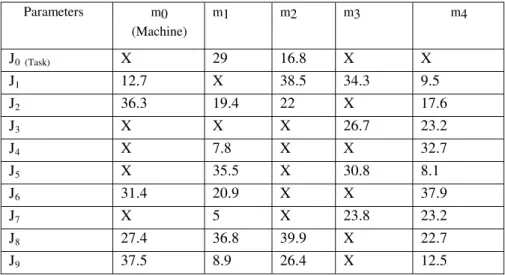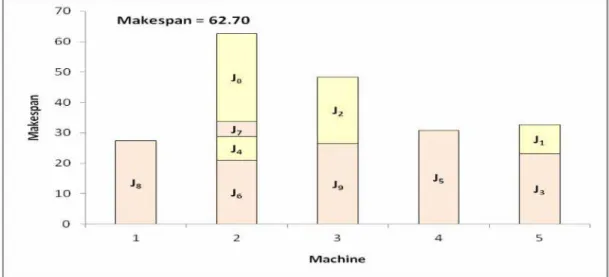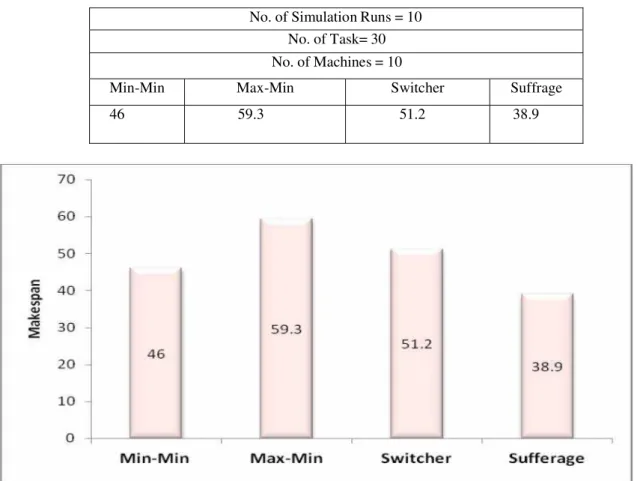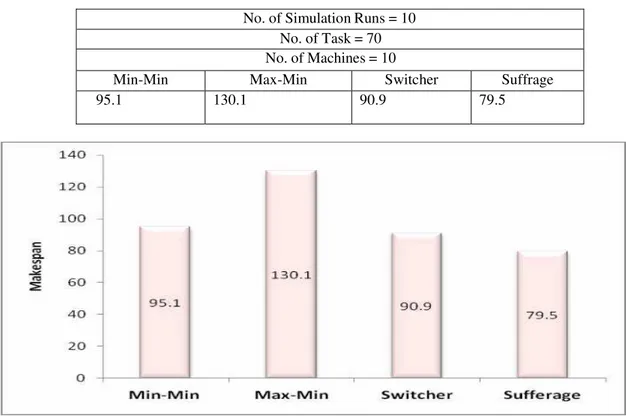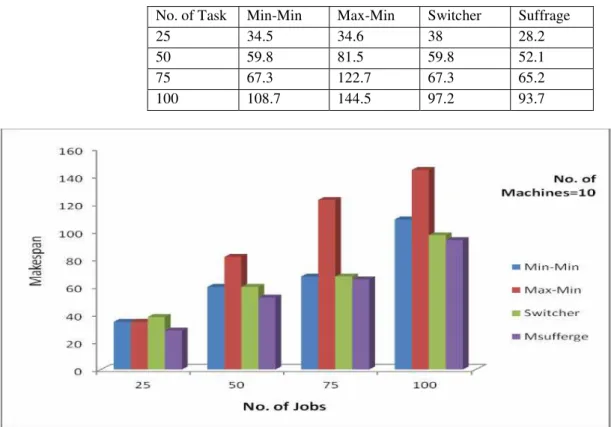Heuristic Based Task Scheduling In Grid
Kamali Gupta 1, Manpreet Singh21Department of Computer Engineering, GIMT, Kanipala, Kurukshetra, Haryana,, India kamaligupta@gimtkkr.com
2Department of Computer Engineering, M.M. University, Mullana, Ambala, Haryana,, India
drmanpreetsinghin@gmail.com
Abstract— Grid computing is concerned with coordinated resource sharing and problem solving in dynamic, multi-institutional virtual organizations. Efficient scheduling of complex applications in a grid environment reveals several challenges due to its high heterogeneity, dynamic behavior and space shared utilization. Objectives of scheduling algorithms are increase in system throughput, efficiency and reduction in task completion time. The main focus of this paper is to highlight the merits of resource and task selection technique based on certain heuristics.
Keyword- Grid Computing, Task Scheduling, Min-Min, Max-Min, Suffrage, Makespan.
I. INTRODUCTION
The term grid [1] is increasingly appearing in computer literature, generally referring to some form of system framework into which hardware or software components can be plugged and which permits easy configuration and creation of new functionality from existing components. Grids enable the sharing, selection and aggregation of a wide variety of resources including supercomputers, storage systems, data sources and specialized devices that are geographically distributed and owned by different organizations for solving large- scale computational and data intensive problems in science, engineering and commerce [2]. The computing power of grid is aggregated by that of various organizational or individual computing resources and grid users need only to submit computational tasks to it. There are still some difficult issues impeding the development of grid, among which is the issue of grid task scheduling [3][4]. In order to efficiently utilize available grid resources and promptly complete tasks assigned to the grid, providing a suitable task scheduling strategy for the grid computing is necessary [5][6].
The objective of this research work is to make a comparison among various heuristic based scheduling algorithms under different resource/task mapping environments. In Min-Min algorithm [7], the smaller tasks are chosen first, making use of resources with high computational power. As a result, the schedule prepared by Min- Min is not optimal when number of smaller tasks exceeds the larger one. Max-Min algorithm [9] schedules larger tasks first. But in some cases, the makespan may increase due to the execution of larger tasks first. The rationale behind Suffrage [10] is that a task should be assigned to a certain resource and if it does not go to that resource, it will suffer the most. For each task, its suffrage value is defined as the difference between its best Minimum Completion Time (MCT) and its second-best MCT. Tasks with high suffrage value take precedence during scheduling.
II HEURISTIC BASED SCHEDULING ALGORITHMS
The resource selection process is used to choose one or more resources from the list of candidates for a given resource requirement. Since all resources in the list could meet the minimum requirements imposed by the task, so an algorithm is needed that can choose the best resource for executing the task.
Min-Min Algorithm: Min-Min [8] begins with the set MT (Meta Task) of all unassigned tasks and has two phases. In the first phase, the set of minimum expected completion time for each task in MT is found. In the second phase, the task with the overall minimum expected completion time from MT is chosen and assigned to the corresponding macine. Then this task is removed from MT and the process is repeated until all tasks in the MT are mapped as shown in Fig. 1. However, the Min- Min algorithm is unable to balance the load well as it usually does the scheduling of small tasks initially.
BEGIN
1. While (J != Null) // J is set of jobs 2. For each job ji £ J
Calculate the completion time
Cij = Eij + Rj // Cij, Eij and Rj represents completion time, execution time and ready time of job ji on machine mj
End For End For
3. For each job ji £ J
Find the minimum completion time and the machine that obtains it. End For
4. Search the job ju having minimum completion time among all unassigned jobs.
5. Allocate ju to machine mv that has resulted in obtaining minimum completion time of ju.
6. Delete job ju from the job set J: J = J - ju 7. Update the ready time of machine mv as: Rv = Cuv
End While END
Fig. 1: The Min-Min Heuristic
Max-Min Algorithm: Max-Min [10] differs from Min-Min in second phase, where tasks with overall maximum
expected completion time from MT is chosen and assigned to corresponding machine as shown in Fig. 2. In other words, Min-Min gives priority to the task that has the shortest earliest completion time, whereas at the time of each scheduling instance, Max-Min tends to schedule the longer task first.
BEGIN
1. While (J != Null) 2. For each job ji £ J
For each machine mj
Calculate the completion time
Cij = Eij + Rj // Cij, Eij and Rj represents completion time, execution time and ready time of job ji on machine mj
End For End For
3. For each job ji £ J
Find the minimum completion time and the machine that obtains it. End For
4. Search the job ju having maximum completion time among all unassigned jobs.
5. Allocate ju to machine mv that has resulted in obtaining maximum completion time of ju. 6. Delete job ju from the job set J: J = J - ju
7. Update the ready time of machine mv as: Rv = Cuv End While
END
Fig. 2: The Max-Min Heuristic
Switcher Algorithm: Switcher [12] selects between the Max-Min and Min-Min algorithm on the basis of
Standard Deviation (SD) of minimum completion time of unassigned jobs. As the name depicts, it switches between the two algorithms selecting the best between the two, while making each scheduling decision. A position in the list of unassigned jobs where the difference in completion time between the two successive jobs is more than the value of SD is searched. If it lies in first half of the list, then Min-Min algorithm is evaluated as the number of longer jobs is more, otherwise Max-Min is evaluated by taking the last job from the list. If this position does not exist, then SD is compared with a threshold value. Allocation of job to a machine is implemented using Min-Min strategy, if SD is smaller than threshold value. Otherwise, Max-Min is selected for assigning the next job as shown in Fig. 3.
BEGIN
1. While (J != Null) 2. For each job ji £ J
For each machine mj
Calculate the completion time
Cij = Eij + Rj // Cij, Eij and Rj represents completion time, execution time and ready time of job ji on machine mj
End For End For
3. For each job ji £ J
4. Calculate the SD of completion time of all unassigned jobs.
5. Sort all unassigned jobs in increasing order of their completion times.
6. Find a position in this list where difference in completion time of two consecutive jobs is more than SD. 7. If this position is in the 1st half of list of unassigned jobs or SD< threshold value
Apply min-min heuristic
END
Else
End While
Apply max-min heuristic
Fig. 3: The Switcher Heuristic
Suffrage Algorithm: In Suffrage [11], the minimum and second minimum completion time for each job are
found in first step. The difference between these two values is defined as suffrage value as shown in Fig. 4. In second step, the task with maximum suffrage value is assigned to corresponding machine with minimum completion time.
BEGIN
1. While (J != Null) 2. For each job ji £ J
For each machine mj
Calculate the completion time
Cij = Eij + Rj // Cij, Eij and Rj represents completion time, execution time and ready time of job ji on machine mj
End For End For
3. For each job ji £ J
(a) Find the First minimum completion time (FST_MCTi) and second minimum completion time (SEC_MCTi) of job ji.
(b) Calculate the suffrage value: SVi = SEC_MCTi - FST_MCTi End For
4. Search the job ju having maximum suffrage value among all unassigned jobs.
5. Allocate ju to machine mv that has resulted in obtaining minimum completion time of ju.
6. Delete job ju from the job set J: J = J - ju 7. Update the ready time of machine mv as: Rv = Cuv
End While
END
Fig. 4: The Suffrage Heuristic
III AN ILLUSTRATION OF SCHEDULING ALGORITHMS
This section presents the generated schedule for various task scheduling algorithms with the help of an example. Consider the Expected Time to Compute (ETC) matrix as represented in Table 1. The table shows the expected execution times of 10 unassigned jobs on 5 machines. X denotes that the machine does not have capability to execute that particular job.
Table 1 ETC Matrix of Unassigned Tasks
Parameters m0
(Machine)
m1 m2 m3 m4
J0 (Task) X 29 16.8 X X
J1 12.7 X 38.5 34.3 9.5
J2 36.3 19.4 22 X 17.6
J3 X X X 26.7 23.2
J4 X 7.8 X X 32.7
J5 X 35.5 X 30.8 8.1
J6 31.4 20.9 X X 37.9
J7 X 5 X 23.8 23.2
J8 27.4 36.8 39.9 X 22.7
Fig. 7: Makespan Under Switcher Algorithm
Fig. 5 shows the result for Min-Min with makespan = 53.10 using above specified predicted execution times of unassigned tasks.
Fig. 5: Makespan Under Min-Min Algorithm
After applying the Max-Min algorithm, the generated schedule is presented in Fig. 6 with makespan = 62.70 .
Fig. 6: Makespan Under Max-Min Algorithm
Fig. 9: Makespan Under Low Load Conditions
Fig. 8 presents the resulted schedule for Suffrage algorithm with makespan = 42.60.
Fig. 8: Makespan Under Suffrage Algorithm
IV SIMULATION RESULTS & DISCUSSION
This section presents the comparison among various task scheduling algorithms. The functional code is implemented using simulator built in Java on an Intel core 2 duo, 2 GHz window based laptop to evaluate the performance of various scheduling algorithms under different load conditions in terms of variation in number of tasks as shown in Table 2 (Fig. 9), Table 3 (Fig. 10), Table 4 (Fig. 11) and Table 5 (Fig. 12).
Scenario 1: Systems having low load
Table 2 Performance Under Low Load Conditions
No. of Simulation Runs = 10 No. of Task= 30 No. of Machines = 10
Min-Min Max-Min Switcher Suffrage
Fig. 11: Makespan Under High Load Conditions
Scenario 2: Systems having medium load
Table 3 Performance Under Medium Load Conditions
No. of Simulation Runs = 10 No. of Task = 70 No. of Machines = 10
Min-Min Max-Min Switcher Suffrage
95.1 130.1 90.9 79.5
Fig. 10: Makespan Under Medium Load Conditions
Scenario 3: System having high load
Table 4 Performance Under High Load Conditions
No. of Simulation Runs = 10 No. of Task = 120 No. of Machines = 10
Min-Min Max-Min Switcher Suffrage
Comparison among different heuristics under various load conditions is shown in Fig. 12.
Table 5 Performance Under Different Load Conditions
No. of Task Min-Min Max-Min Switcher Suffrage
25 34.5 34.6 38 28.2
50 59.8 81.5 59.8 52.1
75 67.3 122.7 67.3 65.2
100 108.7 144.5 97.2 93.7
Fig. 12: Makespan of Different Heuristics Under Various Load Conditions
V CONCLUSION
In this paper, the working of various task scheduling algorithms is presented. The main goal of task scheduling is to reduce the overall makespan of the jobs submitted in the grid. When it gets minimized, the performance of entire grid gets optimized automatically. A performance comparison among various scheduling heuristics has been made under various load conditions in terms of variation in number of tasks and task length. The heuristic with shortest makespan is declared the best to perform task scheduling in grid. Simulation result shows that the Suffrage scheduling algorithm generates an optimum schedule and outperforms the other conventional algorithms.
REFERENCES
[1] I. Foster, and C. Kesselman, The Grid: Blueprint for a new Computing Infrastructure, 2nd ed.: Morgan Kauffman publishers, 2004. [2] R. Buyya and S. Venugopal, “A Gentle Introduction to Grid Computing and Technologies” CSI Communication, pp. 9-19, July 2005.
[3] Z. Jinnquan, N. Lina and J. Changjun, “A Heuristic Scheduling Strategy for Independent Tasks on Grid”, in Proc. 8th Inter. Conf. on
High-Performance Computing in Asia-Pacific Region (HPCASIA’05), 2005, pp. 588-593.
[4] H. Zhang, C. Wu, Q. Xiong, L. Wu and G. Ye, “Research on an Effective Mechanism of Task-scheduling in Grid Environment”, in
Proc. 5th Inter. Conf. on Grid and Cooperative Computing, 2006, pp. 86-92.
[5] H. Baghban and M. Rahmani, “A Heuristic on Job Scheduling in Grid Computing Environment”, in Proc. 7th Inter. Conf. on Grid and
Cooperative Computing (GCC’08), 2008, pp. 141-146.
[6] G. Hong-cui1, Y. Jiong, H. Yong and L. Hong-wei, “User QoS and System Index Guided Task Scheduling in Grid Computing”, in
Proc. 3rd China Grid Annual Conference, 2008, pp. 109-112.
[7] T. Kokilavani and D. Amalarethinam, “Load Balanced Min-Min Algorithm for Static Meta-Task Scheduling in Grid Computing”,
International Journal of Computer Applications, Vol.20, No.2, pp 43-49, 2011.
[8] M. Wu, W. Shu and H. Zhang, “Segmented Min-Min: A Static Mapping Algorithm for Meta-Tasks on Heterogeneous Computing
System”, in Proc. 9th Heterogeneous Workshop (HCW’00), 2000, pp. 375-385.
[9] E. Munir, J. Li , S. Shi and Q. Rasool, “ Performance Analysis of Task Scheduling Heuristics in Grid”, in Proc. 6th Inter. Conf. on
Machine Learning and Cybernetics, 2007, pp. 3093-3098.
[10] M. Maheswaran, S. Ali, H. J. Siegel, D. Hensgen and R. F. Freund, “Dynamic Matching and Scheduling of a Class of Independent tasks onto Heterogeneous Computing Systems,” Journal of Parallel and Distributed Computing, Vol. 59, No. 2, pp. 107-131,1999.
[11] E. U. Munir, J. Li and S. Shi, “QoS Sufferage Heuristic for Independent Task Scheduling in Grid,” Information Technology Journal, Vol. 6, No. 8, pp. 1166-1170, 2007.
[12] M. Singh andP.K.Suri, “QPSMax-Min<>Min-Min : A QoS Based Predictive Max-Min, Min-Min Switcher Algorithm for Job Scheduling in a Grid”, Information Technology Journa,l Vol. 7, No. 8, pp. 1176-1181, 2008.
